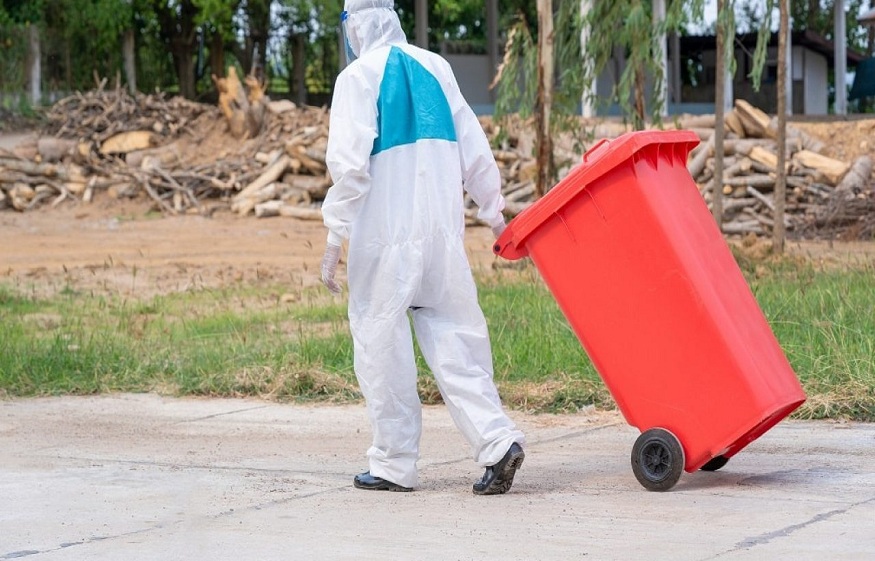Properly disposing of hazardous waste in the UK is crucial to safeguard human health and the environment. While the process may appear intricate, adhering to the following nine major steps will help you navigate the complexities of hazardous waste disposal. By following these guidelines, you can ensure compliance with regulations and avoid the potential fines and legal complications that may arise. So, let’s dive into the process and conquer the challenge of disposing of hazardous waste in the UK!
Step 1: Register Your Premises
If your business generates or stores more than 500 kg of hazardous waste within a twelve-month period, it is vital to register and obtain an official licence. This registration process helps the government monitor and regulate hazardous waste production effectively. To register, visit the Hazardous Waste Producer Registration page provided by the government. It’s essential to ensure compliance right from the start!
Step 2: Classify the Waste You Produce
Accurate classification of the waste your business generates is a fundamental step in the disposal process. This classification assists in determining the appropriate handling methods and ensures compliance with waste management regulations. Completing the necessary paperwork is crucial, as it provides essential information such as the waste’s classification code, its origin, and chemical and physical analysis. Remember to forward this information to a local waste management contractor to facilitate proper waste management.
Step 3: Separation and Storage
Once you have successfully classified and reported your hazardous waste, it’s time to focus on sorting and storing it correctly. Proper separation of hazardous and non-hazardous waste is of utmost importance to prevent any potential cross-contamination. Additionally, it is advisable to store different types of hazardous waste separately to minimise the risk of unexpected chemical reactions.
Ensure you store the waste in a secure place, preferably in durable containers that can withstand the hazardous materials. Consider covering the containers to further mitigate potential risks. Dedicate a specific area solely for the storage of hazardous waste, clearly marking it with warning signs to alert individuals to the potential dangers. Safety should always be the top priority!
Step 4: Use an Authorised Hazardous Waste Collector
When the volume of hazardous waste exceeds manageable limits or poses potential risks, it is crucial to engage the services of a registered hazardous waste collector. However, before selecting a waste removal company, it is essential to conduct thorough background checks to ensure their competence and legitimacy.
Not all waste removal experts offer hazardous waste collection so it’s important to verify their capabilities beforehand. To find registered waste carriers, consult the government’s website, where you can access a list of authorised professionals who specialise in hazardous waste collection. Trustworthiness and expertise should guide your decision-making process!
Step 5: The Consignment Note
Before the hazardous waste is transported away, it is vital to complete a consignment note, an official document that accompanies the waste. This document provides essential information about the waste being transported and acts as a record of the disposal process.
You can download the consignment note form from the government’s website, ensuring that all necessary details are accurately filled in. It is crucial to provide a copy of the consignment note to the waste removal company upon their arrival for waste collection. This step helps maintain transparency and accountability throughout the disposal process.
Step 6: Keep Records
Maintaining comprehensive records is vital, as your business or operation may undergo inspections from various institutions in the future. It is essential to store these records at the registered premises where the waste is produced or at your main office if your premises are not registered.
These records should include any relevant documents, copies of consignment notes, and consignee returns received from businesses that accept your waste. Keeping meticulous records demonstrates your commitment to responsible waste management and aids in future regulatory compliance.
Step 7: Prepare for Waste Transport
Before moving hazardous waste, it is essential to take the necessary precautions to ensure the safety of the waste handlers, the general public, and the environment. Proper packaging and labelling are crucial during this stage.
- Use Appropriate Containers – Select leak-proof containers that are specifically designed for hazardous waste transportation. Ensure the containers are in good condition, without any cracks or defects that could lead to leaks. It’s recommended to use containers made of materials such as high-density polyethylene (HDPE) or steel.
- Secure the Containers – Properly seal and secure the containers to prevent any accidental spills or leaks during transportation. Use appropriate sealing methods such as tight-fitting lids, gaskets, or tamper-evident seals. Secure the containers in a way that minimises movement and potential damage during transit.
- Labelling Requirements – Clearly label each container with the necessary information as required by regulations. This includes the UN number, hazard symbols, waste codes, and any specific handling instructions. Accurate labelling helps waste handlers identify the nature of the contents and handle them appropriately.
- Transport Documentation – Prepare all the necessary transport documentation, including the consignment note and any additional permits or licences required for transporting hazardous waste. Keep these documents readily available for inspection during transit.
Step 8: Arrange for Disposal or Treatment
When disposing of hazardous waste, it is crucial to engage authorised facilities that specialise in waste treatment or disposal. These facilities have the necessary permits and expertise to handle hazardous materials safely. Coordinate with the chosen facility to arrange for the proper treatment or disposal of the waste, ensuring compliance with environmental regulations and best practices.
Step 9: Monitor and Review Waste Management Practices
Once the hazardous waste has been disposed of or treated, it is important to monitor and review your waste management practices regularly. Assess the effectiveness of your procedures and make any necessary adjustments or improvements to ensure ongoing compliance with waste management regulations. Continuous monitoring and improvement contribute to long-term sustainability and responsible waste management practices.
Final Words
Incorporating these nine essential steps into your hazardous waste disposal process ensures a safe and responsible approach in the UK. From registering your premises and accurately classifying the waste to engaging authorised waste collectors and completing comprehensive documentation, every action contributes to a cleaner environment and the well-being of all.
To maintain compliance and drive continuous improvement, keep meticulous records, monitor waste management practices, and stay up to date with evolving regulations. By doing so, you actively contribute to a sustainable future and the protection of human health.
Embracing these steps ensures that your hazardous waste disposal aligns with industry best practices while minimising any negative impact on the environment. Let’s work together to create a greener and safer world through responsible waste management in the UK.




